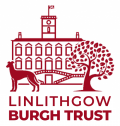Burgh Beautiful Linlithgow
Wildflowers, Wildlife and Biodiversity

Burgh Beautiful likes to play its part in promoting biodiversity, principally by encouraging the growth of wildflowers and by creating or conserving appropriate habitats. Here are some examples.
Wildflowers at the Kettilstoun Cycle Ramp
The slopes adjacent to a highly engineered ramp leading up to the Union Canal, installed in 2014 by West Lothian Council, gave the ideal opportunity to create a wildflower habitat, as shown on the left. After receipt of a grant from Foundation Scotland, initial species were identified and seeds of Yellow Rattle and Red Campion scattered. The first clearing and planting session took place in 2017, since when top growth has been removed at a well-attended family-friendly every autumn. An interpretation board was installed by West Lothian Council in February 2021.
In 2024, the list of flower species was recorded as: Bramble, Bird’s-foot trefoil, Bugle, Cat’s-ear, Cleavers, Clover (red and white), Cranesbill, Common mouse-ear, Common mallow, Common mugwort, Common vetch, Corn cockle, Corn marigold, Cow parsley, Cowslip, Creeping buttercup, Daisy, Dandelion, Dead nettle, Dock, Dog rose, Everlasting pea, Few-leaved Hawkweed, Field-speedwell, Forget-me-not, Foxglove, Herb-Robert, Herb Bennet, Hogweed, Kidney vetch, Knapweed, Lady’s bedstraw, Lady’s smock, Meadow buttercup, Meadow vetchling, Meadowsweet, Mouse-ear hawkweed, Nettle, Nipplewort, Ox-eyed daisy, Plantain, Primrose, Poppy, Red campion, Rough Hawk’s-beard, St John’s-wort, Scabious, Scarlet pimpernel, Self-heal, Sheep’s sorrel, Shepherd’s-purse, Sow thistle, Spear thistle, Spotted Medick, Stitchwort, Thyme-leaved sandwort, Violet, Vipers Bugloss, Willowherb, Yarrow, Yellow rattle.
Wildflowers at Rosemount Park
Of more recent vintage are the wildflower meadows created by West Lothian Council at Rosemount Park (as shown on right) and Beechwood Park. At Rosemount Park, there are three fairly substantial wild flower areas, mainly on gentle northwest-facing slopes, also accompanied by an interpretation board. The top growth in these areas is cleared early each autumn. Also within the park area (and nearby at a site in the residential area at Priory Road), there are some areas where the grass is kept longer, partly to encourage greater diversity of wildlife. In the waterlogged area below the Friars’ Well in the centre of the park, Burgh Beautiful has planted a range of suitable plants such as irises and marsh marigolds, to create further interest and some added colour. The creation of an arboretum in the park, another Burgh Beautiful project, is described in the dedicated ‘Rosemount Park’ web page.
Learmonth Gardens
Nearby, across the Union Canal, is Learmonth Gardens where the lower areas at the back are maintained for wildlife and biodiversity – again the Council has provided an interpretation board to enable plant species to be identified. Over recent years, Burgh Beautiful volunteers have worked with local schoolchildren to plant additional wildflowers in this area.


Wildlife Pond and Wetland at Kettilstoun
Perhaps Burgh Beautiful’s most (potentially) ambitious project in the field of biodiversity has been the creation of a wildlife pond to the west of the town, in an area of former farmland, partly to mitigate for losses relating to the construction of a major new cycle track. Burgh Beautiful approached R J McLeod, the contractors, who agreed to excavate a ‘scrape’ as a ‘community benefit’ under the company’s Environmental and Sustainability Policy. This has created a pond and wetland area near the recently planted Triangle Wood and below the Union Canal. The site excavated was an old pit/quarry with a small stream, originating from under the Union Canal, now running into and out of the pond. The pond, shown on left, is approximately 18 inches deep, shelving to 12 inches and then a shallow slope at the pond margin.
The provision of a permanent source of open water allows the development of such species as caddis flies, damsel flies and dragonflies through their complete life cycle. To provide a suitable habitat, we added some native flag iris by the pond margin. We also hope to attract amphibians, frogs, newts and toads, providing a safe fish-free habitat for their eggs to develop into tadpoles. For the future, we hope to be able to provide a pond dipping platform, so that children can experience for themselves the fun of coming with their jam jar and seeing (and releasing) all the mini-beasts living in the water. We thank the Linlithgow Community Development Trust for facilitating this project.
Other Biodiversity Initiatives
Well recognised in the town are the ‘wildlife corridor’ represented by the Union Canal, and the important habitat of Linlithgow Loch. This is one of the few sheets of inland water in the Lothians and, together with its surrounding parkland (The Peel), is managed by Historic Environment Scotland.
Burgh Beautiful itself has been very active in the provision of birdboxes, at locations like Doomsdale at the path between Rosemount Park and the site of the Carmelite Friary. At the latter location, recently installed treecreeper boxes have been monitored every five days within the nest recording scheme of the British Trust for Ornithology.
Other initiatives connected to Burgh Beautiful have included wildflower verges at Deanburn Road/Katie Shaws Loan (mentioned also on the Tree/Hedge Planting web page). Thanks to community pressure relating to loss of a previous wildflower verge/hedgerow, Burgh Beautiful volunteers have recently been working with CALA Homes to plant a new hedge and create a new wildflower meadow/native shrubbery. In the meantime, the principal volunteer concerned created a further wildflower verge nearby, as shown on right.

